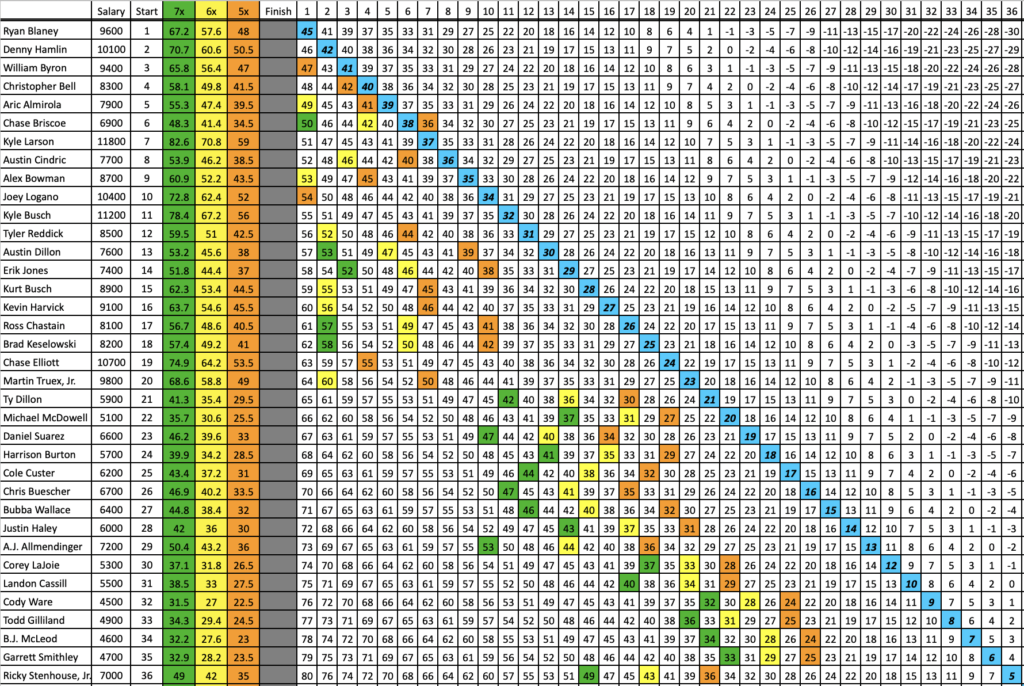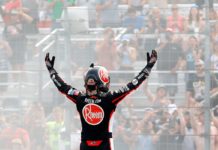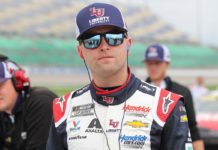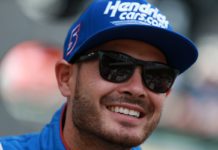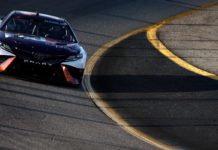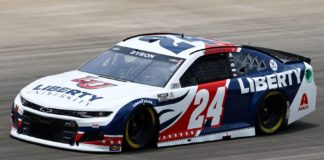After some (rather surprisingly) exciting racing at intermediate tracks the past two weeks, NASCAR heads to the site of the championship race, Phoenix Raceway. Restarts are arguably the craziest on the schedule as drivers fan out on the apron in an attempt to gain some ground on their opponents. It remains to be seen, however, if that will be possible in the new Gen 7 car. Despite the chaotic restarts and championship factor, recent races at Phoenix have been rather boring at times with pit road having the most influence on the race results. Here’s to hoping today’s race and the new car are another step in the right direction!
Pace Laps: Setting the Stage
Phoenix Raceway is a 1.0 mile tri-oval with relatively flat banking that races mostly like a short track. Unlike races at intermediate tracks or superspeedways, nailing the right combination of dominators is essential to DFS success at short tracks due to the increased number of laps and thus, dominator points available. However, the potential for attrition through wrecks remains high, allowing the possibility of punt plays having some success.
Comparable short, flat tracks include Richmond, New Hampshire, and, to a lesser extent, Martinsville, all of which are flatter tracks less than or equal to 1 mile in length. While Richmond and Phoenix have rounded front stretches and wider corners requiring more throttle control, New Hampshire and Martinsville resemble paperclips, putting more emphasis on precise braking. Hence why some drivers succeed at two of them but not the others (e.g. Aric Almirola).
Of note, 27 of the last 34 Phoenix races, albeit on different configurations, have been won by a Cup Series champion. Those who were not champions include NASCAR Hall of Fame drivers, Dale Earnhardt, Jr. and Mark Martin. It goes to show that great skill is needed to succeed at this track, which could be amplified with the new car.
Stage 1: Lineup Construction
- Since the track was reconfigured in 2018, 85.7% of drivers achieving a top 10 DraftKings score started in the top 20.
Passing is difficult at Phoenix with little deviation in running position, unless there are issues or pit road strategy comes into play. Then again, there has been slight improvement with the addition of resin creating multiple racing grooves in the corners. Of the 60 drivers starting top 20 and scoring top 10 in fantasy points, 63.3% of them started in the top 10. On the other hand, drivers starting worse than 30th have only had a top 10 DraftKings score twice. Those performances belonged to Kyle Larson (arguably the best active racer on the planet) and Aric Almirola (whose best two tracks in terms of average finish are Phoenix and Richmond).
- Over the past 7 Phoenix races, 1418 (64.8%) of the laps have been led by a driver starting on the front two rows (positions 1-4).
If excluding the three races that did not have qualifying due to COVID-19 protocols, that figure jumps to 68.5%. Furthermore, if extending to the first three rows (positions 1 through 6), 73.3% of laps led have been accrued by these drivers. When targeting dominators for the race, they should likely come from this range, though GPP pivots from just outside this range could be profitable at lower ownership.
- 23 (65.7%) of the 35 drivers earning top 5 DraftKings scores over the past 7 Phoenix races have made the optimal lineup.
As always, place differential plays will be tempting, but don’t rule out what simply a good finish can do for lineups; 65.2% of these 23 drivers started in the top 10. Place differential didn’t outscore dominator points either as 91.3% of drivers with top 5 fantasy scores had 12 or more fastest laps (6+ dominator points) and 78.2% led at least 32 laps (8 dominator points). Thus, when deciding between high-priced options, dominator potential should trump place differential in GPPs.
- At short, flat tracks over the past two years, optimal lineups have followed a similar trend with regard to pricing.
Before diving any deeper, it must be mentioned that in 2020 and 2021, pricing was released after the starting lineup was set since there was no qualifying; however, similar trends were noticed in previous Phoenix races, so it may be applicable. 10 of 13 optimal DraftKings lineups at the aforementioned comparable tracks included at least 2 drivers priced above $10,000, while 11 of 13 featured one or more punt plays priced below $6,000. Consistent across the past four years at Phoenix, 2 to 3 drivers starting in the top 12 positions have made the optimal lineup with the polesitter being optimal 62.5% of the time.
Stage 2: Drivers to Target
Cash Game Targets
Ryan Blaney ($9,600) – Starting from the pole, there is always a risk. However, the polesitter has averaged 87 laps led over the past 7 Phoenix races. Blaney ranked 2nd in 5-, 10-, 15-, and 20-lap average speed in practice as well, showing that his speed was not just in qualifying trim. Despite his troubles at Richmond, Blaney does have 3 top 5s and 5 top 10s in his past 6 Phoenix races. The #12 car has been fast all season so far, so he should be in prime position to capitalize this week.
Tyler Reddick ($8,500) – Another car that has been consistently fast so far in 2022 is the #8 driven by Tyler Reddick. It may not seem like this track fits his style as much, but he has blossomed into a contender on all track types, even road courses which could be useful at Phoenix. He did turn the 3rd fastest lap in practice and ranked 4th in both 5- and 15-lap average. Drivers who have a similar driving style include Kyle Larson and Noah Gragson, both of whom have won the most recent races in their respective series at Phoenix. A top 5 finish could land Reddick in the optimal, while a top 10 should contribute to winning most cash games.
Bubba Wallace ($6,400) – Starting 27th, Wallace provides place differential upside unmatched by most drivers starting in this range. He tends to run well at short tracks, though usually better at Bristol and Martinsville. He has shown top 15 upside at Phoenix in the past in weaker equipment. In practice yesterday, he ranked 10th in 10-lap average speed, showing that he may have top 10 upside this weekend. Given his low price and mid-20s starting position, Bubba could his 6x value with a 16th place finish.
GPP Targets
Kyle Larson ($11,800) – As mentioned in previous weeks, there is no way to count out the defending Cup Series champion, especially since he won the race here last fall. Larson would have been a cash game target, but he will be starting the race from the rear after unapproved adjustments were made. It may not impact his chances at all, but that risk puts him firmly in the GPP category. Larson topped the charts in overall average practice speed, despite being one of the very few drivers to make a 25 lap run. He looks to have a rocket this weekend and with the high groove afforded by the resin application, he should contend to dominate again.
Harrison Burton ($5,700) – If Reddick doesn’t have the worst luck in the series, Burton does. The young gun has been wrecked in three straight races to start the season, but there is absolutely no reason for him to be priced this low! Driving the #21 Wood Brothers Ford should automatically mean a price above $6,000, but I digress. Similar to Bubba, Burton ranked 10th in 10-lap average in practice. He also has two top 3 finishes at Phoenix in the Xfinity Series. Although he is underpriced, there’s a chance he goes overlooked due to his recent struggles, despite only needing a 16th place finish for 6x value.
Final Lap
21 of the past 30 Cup Series winners at Phoenix have started in the top 10, even though there have been multiple generations of cars in that timeframe. Historically, Kevin Harvick and Kyle Busch have been the drivers to beat at Phoenix, but most of their success came prior to the application of traction compounds which moved the preferred racing groove closer to the wall. While they can be considered simply for their history, it’s important to know the context of the numbers. Also, Ricky Stenhouse Jr. should be a chalky play starting in dead last after an engine issue, but given the unlikely nature of drivers starting worse than 30th and still having a strong performance, being underweight to the field could be beneficial in GPPs.
For any questions or comments, you can always find me on Twitter. Best of luck this weekend! Enjoy the somewhat predictable nature of this race before a new track in Atlanta next week.


